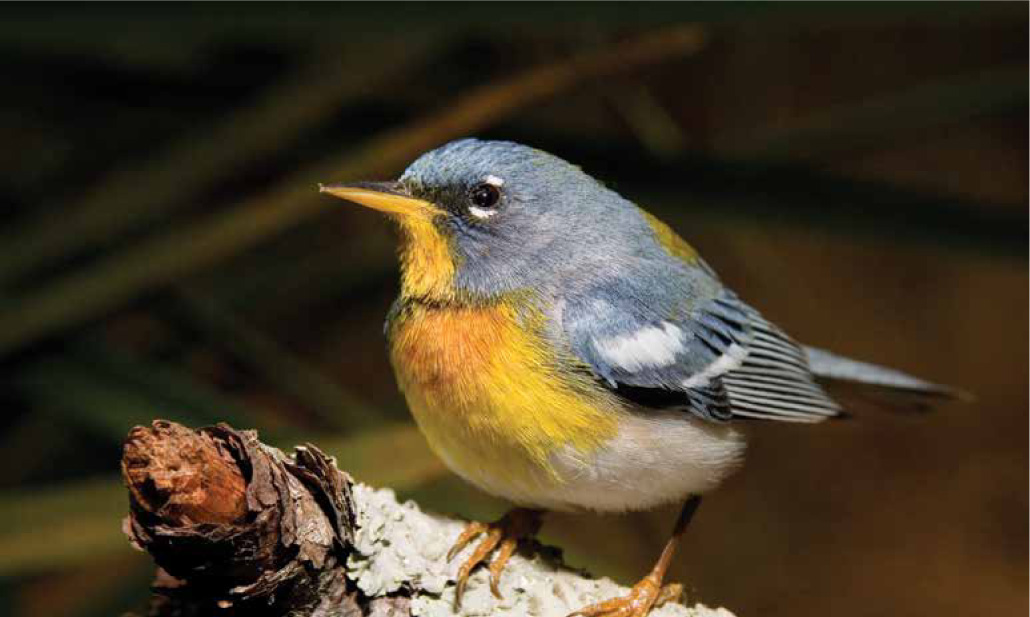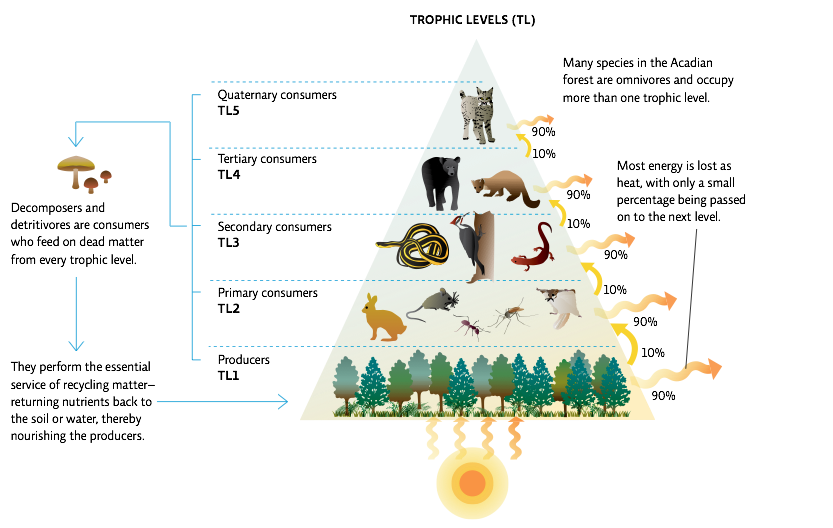8.3 Matter and energy move through a community via the food web
Ecological communities are complex assemblages of all the different species that can potentially interact within an area. Understanding these interconnections allows us to better protect and even help restore damaged ecosystems.
Energy is the foundation of every ecosystem; it is captured by photosynthetic organisms and then passed from organism to organism via the food chain—a simple, linear path that shows what eats what. Any given ecosystem might have dozens—even hundreds—of individual food chains. Linked together they create a food web, which shows all the many connections in the community. Both food chains and webs help ecologists track energy and matter through a given community. They can vary greatly in length and complexity between different types of ecosystems. But most share a few common features and all are made up of the same basic building blocks—namely, consumers and producers. [infographic 8.2]


134
135
Animals, fungi, and most bacteria are consumers—they gain energy and nutrients by eating other organisms. Some of the organisms they consume are producers—photosynthetic organisms such as plants that capture energy directly from the sun and convert it into food (sugar) via photosynthesis. These different feeding levels are known as trophic levels, into which consumers are organized based on what they eat. Primary consumers eat producers; secondary consumers eat primary consumers; tertiary consumers eat secondary consumers, and so on. At the top of the food chain sit the apex predators, in the last trophic level. Of course, some organisms feed at more than one trophic level: for instance, when the ovenbird eats berries or seeds found in leaf litter, it is feeding at trophic level 2 (a primary consumer); when it eats the invertebrates that live in that litter, such as beetle larvae and snails, it is feeding at trophic level 3 (a secondary consumer).
In an ecosystem as diverse and complex as the Acadian forest, there are many different organisms at each trophic level, making for a wide variety of food chains. For example, ovenbirds provide food for other birds such as blue jays, which eat their eggs; chipmunks and red squirrels also feast on ovenbird eggs and young. Both adult ovenbirds and blue jays are, in turn, the prey of martens and red-tailed hawks, which sit at the top of that particular food chain. The black bears that live in Acadian forests eat whatever they can find—anything from tree buds to ants, fruits, nuts, bird eggs, or young deer and moose, making them a versatile consumer in many Acadian forest food chains.
When any of these organisms die, they are eaten by an army of consumers known as detritivores—animals like worms and insects, which feed on dead plants and animals—and decomposers—organisms like bacteria and fungi that break decomposing organic matter all the way down into its constituent atoms and molecules.
As one moves up the food chain, energy and biomass (all the organisms at that level) decrease, creating a trophic pyramid. The reason is simple: nearly every organism uses up the vast majority of its energy and matter in the act of living. So when it is killed and consumed by a predator, it only passes on about 10% (some species pass on more or less than others) of all the energy and matter it consumed during its lifetime. [infographic 8.3]

A pyramid’s ultimate size is determined by the size of its first trophic level—the one made up of photosynthesizing producers, usually plants. More plant growth means more food for primary consumers, which in turn means more food for those organisms above them, and so on up the food chain. The end result is a larger pyramid with more and larger trophic levels. The Acadian forest supports a wide array of animal species in part because of the abundance and variety of plant life found there, particularly during the warmer seasons, which supports life at the higher trophic levels.
Productivity—the amount of energy trapped by producers and converted into organic molecules like sugar—is limited by sunlight and nutrient availability. Gross primary productivity is a measure of total photosynthesis. But plants only use a portion (usually less than 50%) of this energy to fuel their daily needs. Scientists use the term net primary productivity (NPP) to describe how much energy is left over after that. The “net” is a measure of energy available to higher trophic levels—in other words, the amount that’s converted to new growth.
In the Acadian forest, along with most temperate and boreal forests, less sunlight and cooler temperatures limit photosynthesis during winter months, causing plant productivity to slow or shut down completely, resulting in less new growth, and thus less food for other organisms. This is why bears hibernate and birds fly south for the winter: the lack of productivity drives them to these extremes. NPP can be a window into the health of an ecosystem. If it rises or falls unexpectedly, ecologists can look for the cause of the change, which might be an invasion by a non-native plant or a sudden drop in a producer population. Anything that alters NPP can potentially affect organisms at every other level of the trophic pyramid.
136